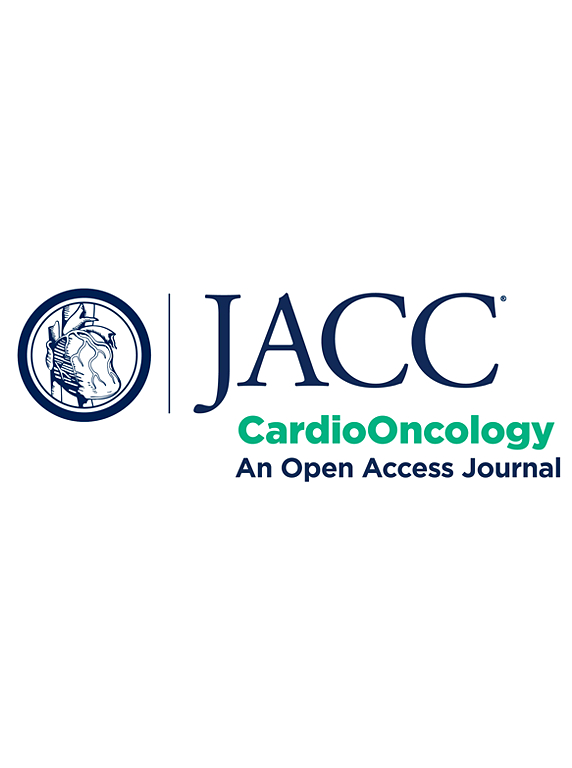SGLT2i Therapy Prevents Anthracycline-Induced Cardiotoxicity in a Large Animal Model by Preserving Myocardial Energetics
IF 12.8
1区 医学
Q1 CARDIAC & CARDIOVASCULAR SYSTEMS
引用次数: 0
Abstract
Background
Anthracycline-induced cardiotoxicity (AIC) is characterized by a disruption in myocardial metabolism.
Objectives
The authors used a large animal model to test sodium-glucose cotransporter inhibitor therapy to prevent AIC.
Methods
Female large white pigs (n = 36) were used to identify the most translational AIC regimen: 6 triweekly intravenous doxorubicin injections (1.8 mg/kg each). Another group of 32 pigs were randomized (1:1:2) to doxorubicin plus empagliflozin 20 mg, doxorubicin plus empagliflozin 10 mg, or doxorubicin control. Pigs were serially examined using multiparametric cardiac magnetic resonance and magnetic resonance spectroscopy. At the end of the 21-week follow-up period, blood samples were obtained to measure myocardial metabolic substrate extraction, and the left ventricle was harvested and processed for analysis using metabolomics, transmission electron microscopy, mitochondrial respirometry, and histopathology.
Results
Final left ventricular ejection fraction (LVEF), the prespecified primary outcome, was significantly higher in pigs receiving 20 mg empagliflozin than in the doxorubicin control group (median 57.5% [Q1-Q3: 55.5%-60.3%] vs 47.0% [Q1-Q3: 40.8%-47.8%]; P = 0.027). Final LVEF in pigs receiving 10 mg empagliflozin was 51% (Q1-Q3: 46.5%-55.5%; P = 0.020 vs 20 mg empagliflozin). The incidence of AIC events was 0%, 50%, and 72% in the empagliflozin 20 mg, empagliflozin 10 mg, and doxorubicin control groups, respectively. Empagliflozin 20 mg treatment resulted in enhanced ketone body consumption by the myocardium, preserved magnetic resonance spectroscopy–measured cardiac energetics, and improved mitochondrial structure and function on transmission electron microscopy and respirometry. These changes were more modest with the 10-mg empagliflozin dose.
Conclusions
Sodium-glucose cotransporter-2 inhibitor therapy with empagliflozin exerts a dose-dependent cardioprotective effect against AIC. The improved LVEF was accompanied by enhanced ketone body consumption, improved cardiac energetics, and preserved mitochondrial structure and function.
在大型动物模型中,SGLT2i治疗通过保留心肌能量来预防蒽环类药物引起的心脏毒性
丹红环素引起的心脏毒性(AIC)以心肌代谢紊乱为特征。目的采用大型动物模型,观察钠-葡萄糖共转运蛋白抑制剂治疗对AIC的预防作用。方法选用36头雌性大白猪,确定最具转化性的AIC方案:6次静脉注射阿霉素(每次1.8 mg/kg),每3周。另一组32头猪按1:1:2的比例随机分为阿霉素加恩帕列净20 mg、阿霉素加恩帕列净10 mg和阿霉素对照组。采用多参数心脏磁共振和磁共振波谱对猪进行了连续检查。在21周的随访期结束时,采集血液样本以测量心肌代谢底物的提取,并采集左心室并进行代谢组学、透射电镜、线粒体呼吸测量和组织病理学分析。结果:最终左室射血分数(LVEF),即预先设定的主要终点,在接受20mg恩格列净治疗的猪中,显著高于阿霉素对照组(中位数57.5% [Q1-Q3: 55.5%-60.3%] vs 47.0% [Q1-Q3: 40.8%-47.8%];p = 0.027)。接受10 mg恩格列净的猪最终LVEF为51% (Q1-Q3: 46.5%-55.5%;P = 0.020 vs 20 mg恩格列净)。伊帕列净20 mg、伊帕列净10 mg和阿霉素对照组AIC事件的发生率分别为0%、50%和72%。恩格列净20mg治疗后,心肌酮体消耗增加,磁共振波谱测量的心脏能量保持不变,透射电镜和呼吸仪显示线粒体结构和功能改善。这些变化在10mg恩帕列净剂量组更为温和。结论恩格列净联合钠-葡萄糖共转运蛋白-2抑制剂治疗对AIC具有剂量依赖性的心脏保护作用。改善的LVEF伴随着酮体消耗的增加,心脏能量的改善,线粒体结构和功能的保留。
本文章由计算机程序翻译,如有差异,请以英文原文为准。
求助全文
约1分钟内获得全文
求助全文
来源期刊

Jacc: Cardiooncology
Multiple-
CiteScore
12.50
自引率
6.30%
发文量
106
期刊介绍:
JACC: CardioOncology is a specialized journal that belongs to the esteemed Journal of the American College of Cardiology (JACC) family. Its purpose is to enhance cardiovascular care for cancer patients by publishing high-quality, innovative scientific research and sharing evidence-based knowledge.
The journal aims to revolutionize the field of cardio-oncology and actively involve and educate professionals in both cardiovascular and oncology fields. It covers a wide range of topics including pre-clinical, translational, and clinical research, as well as best practices in cardio-oncology. Key areas of focus include understanding disease mechanisms, utilizing in vitro and in vivo models, exploring novel and traditional therapeutics (across Phase I-IV trials), studying epidemiology, employing precision medicine, and investigating primary and secondary prevention.
Amyloidosis, cardiovascular risk factors, heart failure, and vascular disease are some examples of the disease states that are of particular interest to the journal. However, it welcomes research on other relevant conditions as well.
 求助内容:
求助内容: 应助结果提醒方式:
应助结果提醒方式:


